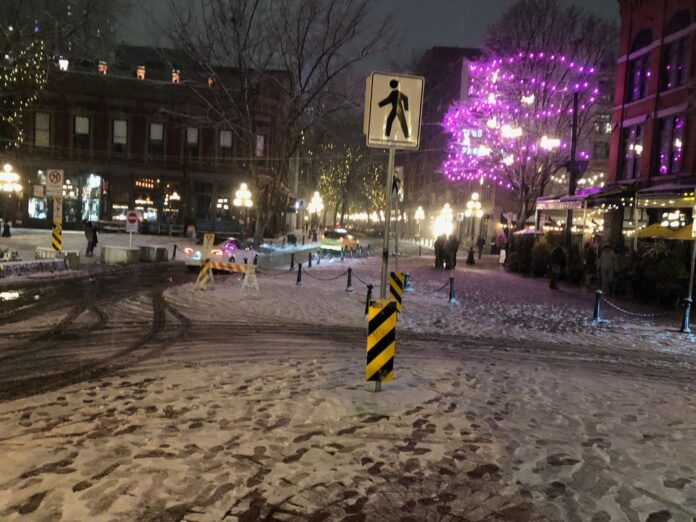WITH a second blast of snow headed to Vancouver, the City says its crews are busy preparing roads and planning for a full-scale response. Forecasts are calling for up to 20 centimetres of snow on Wednesday and the City is urging residents to stick to essential travel only and reminding the public that supports are in place to stay safe during extreme cold.
Currently the crews are out pre-treating all priority routes as per the City’s winter maintenance plan . Priority routes include major roads, bus routes, bridges within City limits, and main streets adjacent to major hospitals. The City also treats its four major pedestrian pathways (Arbutus Greenway, Central Valley Greenway, False Creek Seawall, and Coal Harbour Seawall) and the 16 most-used bike routes.
Crews prioritize treatment of pedestrian pathways before adjacent bikeways. Residential side streets are not included as part of the City’s treatment plans, with the exception of priority hills and access routes to hospitals and schools.
What residents can do:
- The best way to stay safe during snow is to only undertake essential travel. Keeping roads clear allows City crews to do their work. If you must drive make sure you have winter tires, allow more time for travel and stick to priority routes. Use our traffic cameras to check road conditions on your commute.
- Be on alert for winter weather forecasts, and make sure you are prepared:
- Have snow shovels and de-icing materials available and ready to remove snow and/or ice from sidewalks adjacent to private property by 10am the morning after a snow fall. Failure to remove snow and ice within a 24 hour period could result in a fine of $250 to $750 per offence.
- Be safe, be seen. In darker, wet weather, visibility is limited and changing conditions can make it harder to travel. Dress for the weather, including wearing proper footwear, lights and reflective gear and make eye contact with other road users.
- Help others in need. Snow and ice on the sidewalk can be a barrier for many people, particularly seniors and people with mobility challenges. Consider becoming a snow angel and help others when it snows.
- Avoid over salting. Excess road salt damages vehicles and infrastructure, harms our pets and plants, and degrades waterways. Learn about sustainable salt use.
- Keep catch basins clear of snow and ice to prevent flooding. If your local catch basin is blocked, break up and remove any built-up ice. If this does not help, report the blockage to 3-1-1 or via Van311. Learn more about adopting your own catch basin.
For those sheltering outside, the City and its partners have activated options for people to come indoors. The City and its partners are once again activating a variety of additional indoor spaces to ensure that people sleeping outside can come into warm, safe spaces during the coldest, wettest months.
In partnership with BC Housing, the following indoor spaces form the winter shelter strategy:
Temporary winter response shelters
- For the 2023-2024 winter season, there are two temporary winter shelters that will be open every night until March 2024, providing 67 additional shelter spaces. The City is also working with BC Housing to identify opportunities to add additional shelter capacity during the cold season.
Extreme Weather Response (EWR) shelters
- There are approximately 190 EWR beds that provide additional shelter spaces. EWR sites are provincially funded and delivered through partnerships with community-based service providers and faith-based organizations to provide additional temporary emergency shelter spaces during periods of extreme winter weather.
- These spaces are activated based on criteria including:
- Temperatures near zero with rainfall that makes it difficult or impossible for those experiencing homelessness to remain dry
- Sleet or freezing rain or snow accumulation
- Sustained high winds
- Temperatures at or below 0°C, or “feels like” 0°C with wind chill
- Rainfall of at least 50 mm in a 24-hour period
- Alerts are shared with service providers, outreach teams, TransLink, and other partners who can inform people who are experiencing homelessness that there are places to come inside and get warm.
The City of Vancouver funds the activation of additional Warming Centres during periods of extreme cold.
Warming Centres
- The City of Vancouver also activates Warming Centres as a life-saving measure when the temperature reaches -4 degrees Celsius or below (or it feels like -4°C or below).
- Warming Centres are open to all, and depending on the site, visitors may bring their pets, bikes, and carts with them. Hot drinks and snacks are available.
- Carnegie Community Centre will also open early on Tuesday, January 16th and Wednesday, January 17th at 7:00 am.
Where to find more information
- Find the latest information on activated shelter spaces and warming centres PDF file (160 KB), their locations and hours. See a map of these spaces PDF file (223 KB) across the city.
- Information on winter strategies and shelters can be found by visiting the City’s shelter and winter response strategy webpage.
- EWR and Warming Centre alerts are also highlighted on the City’s homepage and across all City of Vancouver social media channels when spaces are activated.
- Warming Centre and EWR alerts are circulated in partnership with the Homelessness Services Association of BC (HSABC) to a variety of agencies serving individuals experiencing homelessness. The HSABC X account (Twitter) also provides up to date information on activations.
